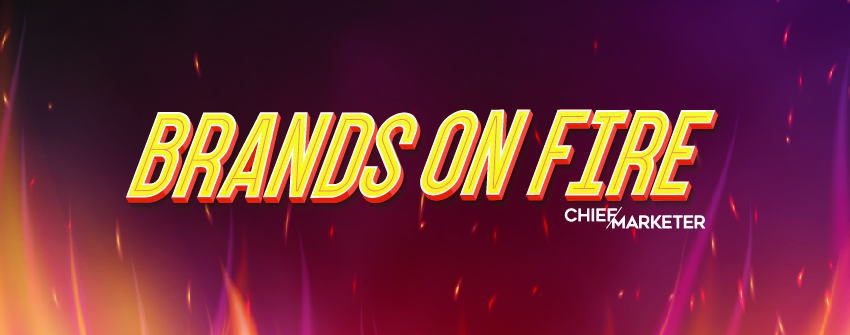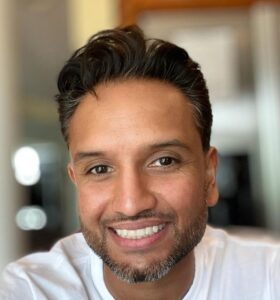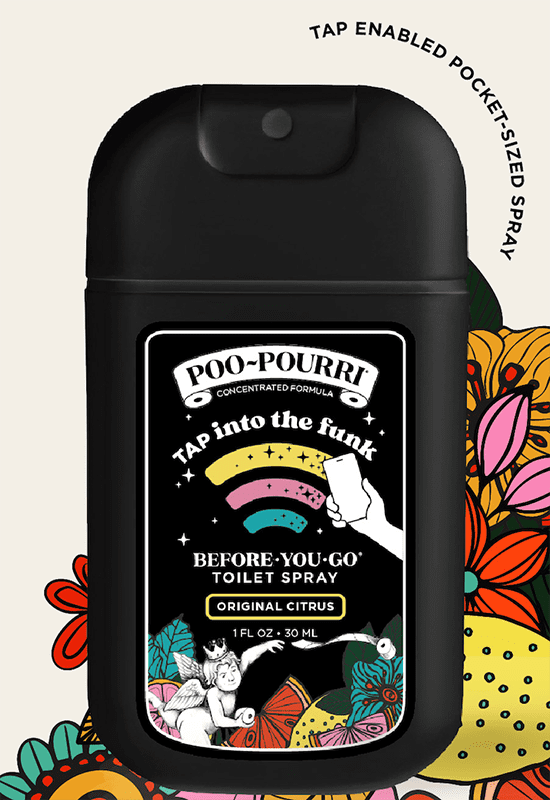Brands on Fire: ~Pourri Taps NFC Technology, Gamified Experiences and Poo-Puns to Woo Consumers

When odor elimination product Poo~Pourri rebranded to the more odor-agnostic ~Pourri a few years ago, it by no means left its original brand identity behind. Because if it had, the copywriting team’s seemingly endless supply of poo-puns would be flushed down the toilet. (See what I mean? Even I couldn’t resist.)
While ~Pourri now offers numerous odor-killing varieties, from Pet~ to Pit~ to Baby~, the Poo~Pourri product, invented by founder Suzy Batiz, remains the OG—and continues to fuel its creative. Beyond clever calls to action like “Meet the Best-Smellers” and “Put A Lid On Diaper Odor,” the brand is also known for delighting fans IRL with cheeky experiences—most famously through its 30-foot-tall inflatable “Giant Poo.”
~Pourri took over SXSW last month with a series of events in partnership with Rolling Stone, and also distributed NFC-enabled “pocket sprayers” (Poo~Pourri samples) festival-wide that unlocked a gamified, multi-touchpoint experience anchored by its forthcoming app. We spoke with ~Pourri CMO Shawn Patel about its SXSW success, the brand’s marketing journey, his strategy for growth, and building a digital community.

Chief Marketer: Talk about the strategy behind your SXSW activation last month.
Shawn Patel, CMO at ~Pourri: We had an opportunity to partner with Rolling Stone, which was a dream of Suzy’s. When that came about, they mentioned SXSW as an opportunity to do a small activation. And when we started talking about it, it was a snowball effect … where we could basically take over SXSW with not just a small activation, but two or three activations throughout it, where we can have thousands and thousands of people attend and have our branding there.
CM: Your sampling strategy at the fest included handing out NFC tech-enabled pocket sprayers. How did that idea come about?
SP: We had been working on the pocket sprayers and the Tap and Go for about nine months. We tested it during the holiday season and saw great success. Even before SXSW was happening, we [thought] this is something we want to launch for all of our products. Then SXSW came about and [we realized] we can have 40, 50, 60,000 people use our app and really test it, and see if it’s something that we can use again across experiential marketing, which is what we’re leaning into for the next couple of years.
[We could] get data from these customers, what’s working, what’s not working. It was a no-brainer for us. We can get products in the hands of people. We can have them sign up to get access to certain activations. We had VIP bathrooms that you can get access to. You had giveaways at the Funk Factory [activation]. Instead of waiting in general admission, you get VIP access to the Funk Factory. Both activations had lines down the street.
CM: There are a lot of lines at SXSW. It’s part of the whole experience.
SP: Instead of just waiting in line, we had brand ambassadors out there, either dressed in our Camp Funk gear or in Disco Ball gear, walking around, giving them the devices and teaching them how to use it. A big thing was education, which we learned really quickly—the first day—when we were handing them out and people weren’t actually signing up for it. It was more about educating them and saying, Hey, if you tap the back of this, you’ll get access to X, Y, and Z.
CM: So you evolved your strategy in the moment. Was it a challenge to ensure everybody was aware of how to use it?
SP: Everything was a challenge. We learned probably a month away from the activation that we were going to have to be all hands on deck. We prepared to have more brand ambassadors there than we actually thought we needed for instances like this. And you can tell by the numbers—after day two, the percentage of growth that we saw in terms of people actually activating the devices.
CM: So the gamification aspect helped you get a lot of data. I’m assuming there are opt-ins in the app to get around the consent issue.
SP: There’s an opt-in when you sign up, so that helps with the whole issue of re-marketing or re-targeting towards them. It was more engagement. Everybody’s got a rewards program, and every reward program is tied to buying or purchasing more. We want to interact and make the customer have fun with us, and then have them be able to interact with each other. That’s the whole point of the app: getting them in, having them play with us, win prizes for using the product—which will eventually lead to sales.

CM: A lot of your marketing is pretty creative, particularly the copywriting. Has that always been a part of the brand?
SP: It’s our foundation. The video that they created back in the day with [a girl] sitting on the toilet—it really took off and catapulted us to where we are now. And we built that into everything we do. The difference now is instead of Poo~Pourri, we are ~Pourri. We hit any type of odor. It is taking that pun humor that we have and elevating it and bringing in education, knowing that our consumer is also getting older and wiser with us.
CM: How are you using tech and gamification moving forward?
SP: Part of this was, let’s make something from an experiential marketing perspective that works. And we can copy and paste to other tentpoles. Also, we’re launching them with all of our products. In 2024, all of our pocket sprayers will be NFC-enabled, and then going forward, all of the new products that we develop will have the NFC technology. So it’ll encourage everybody to tap the back of their product when they use it to engage with the brand.
CM: Can you talk about the brand’s marketing evolution? And what’s next after stepping up the experiential?
SP: The brand has done a really good job in terms of acquiring new customers when we were Poo~Pourri. We’re in more stores across the country than we’ve ever been in. We’ve infiltrated 34,000 Walmart doors. Amazon is taking off; it’s its own animal. And what we’re seeing is that the customer that is willing to buy Poo~Pourri will adhere themselves to every other product that we have as well. So that makes our life a little bit easier in terms of how we build growth in.
And now that we have all of this data and we’re getting consumers to come back and play with us through the gamification process, and we’re doing a lot more brand awareness, we’re stepping up our ad game. We are stepping up all of our influencer, affiliate marketing, et cetera. It’s adding these different layers now to get to that 30, 40% growth that we’re looking for this year.
CM: Where are you placing those ads?
SP: We’re working on making these changes now. We were heavy on Meta—a lot of brands are, because it’s hard to find footing and TikTok, or on any other platform. For the latter half of the year, we’re actually leaning more into TikTok, more into OOV, OTV. We did an incrementality test with an amazing company called Haus.io. I’ve worked with incrementality in the past, and it’s always been too much of a burden on the team, or too expensive to do.
Especially with a brand like us that is heavy in the retail perspective, it gives us a perspective of, if I’m spending money on TikTok and I’m not seeing an ROI right off of the bat, that doesn’t mean that it’s not having an [effect] on our business. We’ve found that TikTok is bringing incrementality. I know that OTV [online TV] and OLV [online video] will bring in incrementality because I’ve done so much of it in the past. Meta will still be a heavy lift for us, just like for any brand. We’re striving toward it being about 60% of what we do from a media perspective, and then the other 40% would be TikTok, OLV and OTV.

CM: The tech crowd at SXSW tends to be opinionated. Were you concerned about unleashing an unfinished product to this particular audience?
SP: One of the reasons we did SXSW is because it’s not just a music festival. It’s not just a film festival. It’s tech, it’s marketing. And if we were launching something new like this, why not do it at SXSW, where there are tech people, like you said, and they’re going to be critical of it? I want the feedback so we get better. I think that know people are scared of failing or putting something out into an area like this, because people will be critical of it. If they’re not going to be critical of it, I’m going to fail anyways from a year from now. I’d rather them be critical now, so I learn, and we grow and get better when we launch.
CM: How are you collecting that feedback?
SP: We captured email addresses and phone numbers, et cetera, so we are sending surveys out. We had a lot of boots on the ground. Myself, the CRO and Suzy were there. We were talking to as many people as we could about the app to get actual feedback.
CM: What’s your strategy for interacting with and engaging consumers moving forward?
SP: We learned a lot from SXSW. Going forward, we are going to continue this. We’re looking for 30% growth over the next year, and continue that into 2025 and expand on our prowess into odor elimination. My goal is to make sure that anytime there’s an odor, you think of ~Pourri.






























